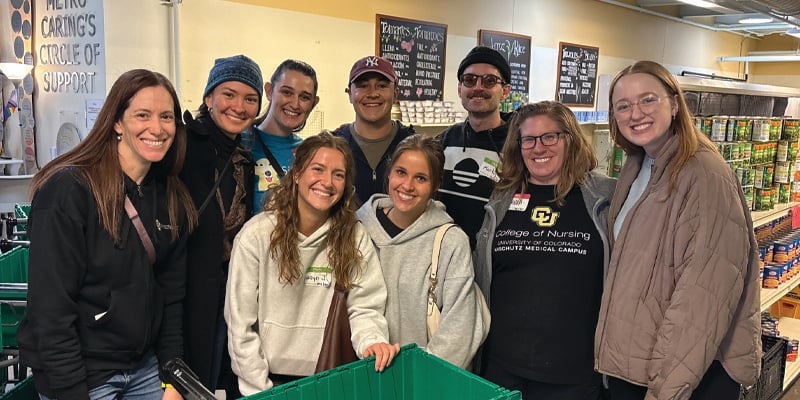Two students in the University of Colorado College of Nursing Adult Gerontology Clinical Nurse Specialist master’s program, Cailly Haning and Cassie Lang, recently published articles about their experiences addressing commonly encountered problems in critical care settings – from oral hygiene with stroke patients to controlling postoperative pain. Haning, MSN, RN, ACCNS-AG, CCRN, and a critical care nurse at Swedish Hospital analyzed hospital-acquired infections due to poor oral hygiene after a stroke. Lang, MSN, CNS, ACCNS-AG, CCRN, a critical care clinical nurse specialist at Memorial Sloan Kettering Cancer Center looked at harnessing a variety of pain management therapies after surgery (acetaminophen, non-steroidal anti-inflammatory drugs, cold and music therapy) to reduce overall opioid consumption.
As an essential component of CU Nursing’s master’s program, students typically identify clinical problems where they work, find a gap in care in their organizations, study it, and provide evidence-based solutions for improvement. These commonly encountered problems in critical care settings become the basis for their evidence-based practice capstone project and presentation. “It puts action into practice and is a great way to think critically and institute best practices while on the job,” said CU College of Nursing Professor and Clinical Nurse Specialist Program Director Mary Beth Makic, PhD. “We then encourage our students to write an article and submit for publication.”
Good Oral Health in Stroke Patients Helps Reduce Infections
CU Nursing Student Caily Haning
A recent article published in Critical Care Nurse by Cailly Haning supports that good oral health assists patients with speaking, eating, and recovery, while reducing inflammation and the likelihood of hospital-acquired pneumonia (HAP). “Critically ill patients are more vulnerable to oral disease because of their physical limitations due to the stroke they suffered,” said Haning. “Nurses are ideally positioned to change the direction of patient care and promote positive outcomes – specifically reducing hospital-acquired infections.“
To reduce bacteria, Haning compared using oral swabs to toothbrushing. “We posed the question, are sponge swabs the best tool to decrease oral bacteria in acutely ill patients with neurological deficiencies?” Conducting a review of the literature, Haning set about to answer that question and develop an evidence-based quality improvement initiative for her unit.
The NCCU where Haning worked experienced one case per month of aspiration-acquired pneumonia, costing on average $19,000 per incident. In review of equipment, it was noted that equipment shortages and incompatibility led nurses to use sponge swabs more frequently than toothbrushes, which are proven more effective in keeping bacteria at bay. By educating the nurses and providing the right tools, Haning showed that a reduction in HAP could be attained. Challenges of implementing this new procedure included high turnover of bedside nurses and leadership. “Changing a practice requires continual engagement with the evidence until the new practice evolves into the cultural norm,” said Haning.
Nurses can help manage postoperative pain by tailoring care to include alternative non-opioid therapies and educating patient expectations
CU Nursing Student Cassie Lang
The opioid crisis has made it necessary to rethink pain management techniques after surgery. “Achieving a pain-free postoperative experience is unlikely. We need to provide patients with a realistic expectation of postoperative pain from the beginning,” said Lang. Perianesthesia nurses are necessary for managing postoperative pain and reducing the risk of opioid misuse. Lang’s article titled Managing Postoperative Pain: Rethinking Adjuvant Therapies appeared in the Journal of PeriAnesthesia Nursing.
Pain is a common postoperative symptom, and managing it is a critical part of healing. Inadequate postoperative pain management affects nearly ½ million people annually. The fear of opioid abuse and misuse is affecting pain management strategies and providing an opportunity to rethink traditional therapies.
“Involving the patient in managing their pain is not a bad thing. Tailoring a regimen to meet the needs of the patient helps reduce overprescribing and misuse,” said Lang. Research shows there are several effective non-opioid options including non-steroidal anti-inflammatory drugs, acetaminophen, ketamine, cold and music therapy, and TENS (transcutaneous electrical nerve stimulation). Patient education plays an important role in managing pain after surgery, and providing the patient with guidelines on how to taper off of medication and alternative therapies to assist with pain, and how to dispose of unused medication can help reduce complications and promote healing.





